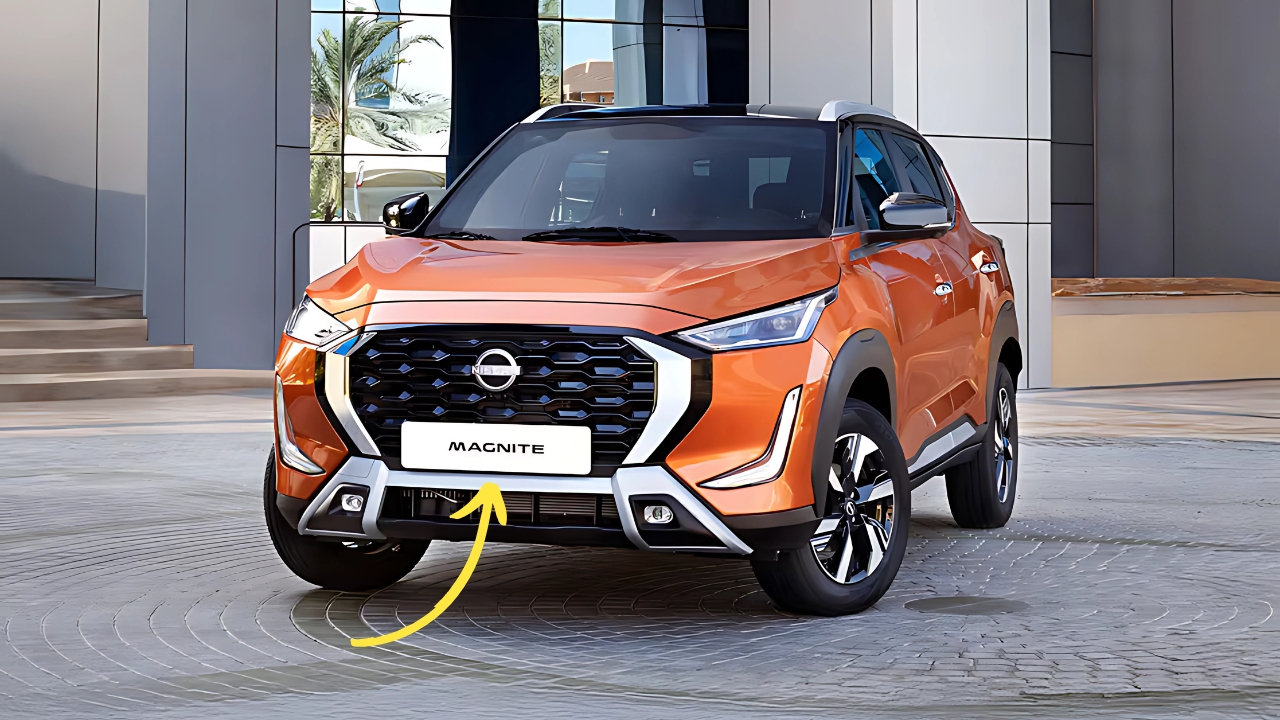Nissan Magnite: In the fiercely competitive compact SUV segment, where manufacturers jostle for attention with increasingly similar offerings, the Nissan Magnite has managed to carve out its own identity.
Launched initially in 2020 and recently refreshed with a facelift, the Magnite represents Nissan’s bold attempt to capture a slice of one of the fastest-growing automotive segments in markets worldwide.
Its name—a clever portmanteau of “magnetic” and “ignite”—hints at the vehicle’s aspirations to attract buyers while igniting their passion for driving.
But does it live up to these lofty ambitions? Let’s take a comprehensive look at what makes the Nissan Magnite stand out in a crowded marketplace.
Nissan Magnite: Design: Bold Statement in a Compact Package
First impressions matter, and the Magnite makes a strong one. The vehicle sports a distinctive design language that manages to be both contemporary and uniquely Nissan.
The front fascia is dominated by the brand’s signature V-motion grille, which has been updated in the facelift with a broader appearance and gloss black finish.
Flanking this are sleek LED headlamps with L-shaped daytime running lights that give the Magnite an unmistakable presence on the road.
The side profile reveals a well-proportioned silhouette with muscular wheel arches housing either 16-inch steel wheels on lower variants or stylish alloy wheels on higher trims.
A slight upward kink in the window line adds visual interest, while the floating roof design (available with dual-tone color options) lends the Magnite a modern touch.
The recent facelift introduced a new Sunrise Copper Orange exterior color that particularly complements the vehicle’s bold character.
At the rear, the Magnite continues its distinctive styling with redesigned 3D effect LED tail lamps that create a wrap-around appearance. The rear bumper features an integrated skid plate that reinforces the SUV’s rugged persona, while the high ground clearance of 205mm ensures the Magnite can tackle rough terrain with confidence.
What’s particularly impressive about the Magnite’s design is how Nissan has managed to pack so much visual presence into a vehicle that measures under 4 meters in length (3994mm to be precise).
This sub-4-meter dimension is significant in markets like India, where it brings tax advantages, but the designers have ensured the Magnite doesn’t look compromised or awkwardly proportioned as some competitors in this category do.
Interior: Punching Above Its Weight Class
Step inside the Magnite, and you’re greeted by a cabin that belies the vehicle’s affordable price point. The dashboard layout is clean and functional, with a driver-oriented center console that places all controls within easy reach.
The facelift has brought significant improvements to the interior ambience, with the addition of copper-colored leatherette accents on the dashboard and door panels adding a premium touch.
The seating position is typical SUV-high, providing good visibility, while the seats themselves offer decent comfort for extended journeys. The front seats are well-bolstered, and the rear bench can accommodate three passengers with reasonable comfort—something not all compact SUVs can claim.
Headroom and legroom are generous for a vehicle in this class, making the Magnite feel more spacious than its exterior dimensions might suggest.
The Magnite’s interior practicality extends to its storage solutions. There are ample cubbies, bottle holders in all doors, a reasonably sized glovebox, and a center console bin.
The boot capacity of 336 liters may not be class-leading, but it’s sufficient for weekend getaways or grocery runs, and the rear seats can be folded to accommodate larger items when needed.
Material quality is where budget constraints become apparent. While the Magnite uses soft leatherette padding on most major touchpoints like the steering wheel and door panels, there are still hard plastics present throughout the cabin.
The fit and finish show some inconsistencies, with noticeable panel gaps around areas like the glovebox and pillars. However, these shortcomings are easier to forgive when considering the Magnite’s aggressive pricing strategy.
Technology and Features: Well-Equipped for the Digital Age
The Magnite surprises with its tech offerings, particularly on higher trim levels. The centerpiece is an 8-inch touchscreen infotainment system that supports wireless Apple CarPlay and Android Auto—a feature often reserved for more expensive vehicles.
The system’s interface is reasonably intuitive, though the screen resolution could be better.
The fully digital instrument cluster, while not the most sophisticated in terms of display quality, provides clear information and adds a modern touch to the dashboard.
Higher variants feature a 360-degree camera system, a genuine rarity in this segment and a feature that proves invaluable when navigating tight parking spaces.
Other noteworthy features include wireless phone charging, automatic climate control with rear AC vents, cruise control, ambient lighting, and a premium audio system. The Magnite also offers connected car technology, allowing owners to access various vehicle functions through a smartphone app.
The facelift has brought improvements to the infotainment graphics and added more safety features, with six airbags now standard across the range—a commendable move in a segment where safety often takes a backseat to cost-cutting.
Additional safety features include electronic stability control, hill start assist, anti-lock brakes with electronic brakeforce distribution, and a tire pressure monitoring system.
One notable omission, especially on the top-spec variants, is a sunroof—a feature increasingly common in the segment and often a deciding factor for buyers in certain markets.
However, Nissan has chosen to focus on more practical features rather than this “nice-to-have” addition.
Performance: Efficient and Adequate
Under the hood, the Magnite offers two petrol engine options: a naturally aspirated 1.0-liter three-cylinder unit producing 71 bhp and 96 Nm of torque, and a turbocharged version of the same engine that delivers a more spirited 99 bhp and 152 Nm.
Both engines can be had with a 5-speed manual transmission, while the naturally aspirated version is available with an AMT (Automated Manual Transmission) and the turbo with a CVT (Continuously Variable Transmission).
The naturally aspirated engine is adequate for city driving but feels strained when asked to perform overtaking maneuvers or climb steep inclines.
The turbo engine, on the other hand, offers noticeably better performance with minimal turbo lag and good mid-range punch. It’s the pick of the range for those who frequently drive on highways or with a full complement of passengers.
The CVT paired with the turbo engine delivers smooth, seamless power and is well-suited to urban environments where stop-and-go traffic is common.
The manual transmission offers more driver engagement, with a reasonably light clutch and precise, if slightly notchy, shifts.
Fuel efficiency is a strong suit for the Magnite, with the naturally aspirated engine returning approximately 19.4 km/l with the manual transmission and 19.7 km/l with the AMT.
The turbo engine delivers around 19.9 km/l with the manual and 17.9 km/l with the CVT—impressive figures that contribute to the Magnite’s appeal as an economical daily driver.
A CNG (Compressed Natural Gas) option has recently been introduced for the naturally aspirated engine, offering even greater economy for budget-conscious buyers in markets where this fuel is readily available.
Ride and Handling: Urban Comfort with Some Compromises
The Magnite’s suspension setup—MacPherson struts with a stabilizer bar up front and twin-tube telescopic shock absorbers at the rear—strikes a reasonable balance between comfort and control.
There’s an underlying firmness to the ride, particularly at low to medium speeds, but it’s rarely uncomfortable unless you encounter significant potholes or sharp bumps.
As speeds increase, the ride quality improves, with the Magnite displaying good high-speed stability and composure.
The 205mm ground clearance allows it to traverse rough patches without scraping its underbody, though it’s worth noting that the Magnite is primarily designed for urban environments rather than serious off-roading.
The steering, while light enough for easy maneuverability in city traffic, lacks feedback and feels somewhat inert.
This won’t bother most buyers who prioritize comfort over driver engagement, but enthusiasts might find it disappointing.
The braking performance is commendable, with the Magnite capable of coming to a standstill from 80 km/h in less than 25 meters—among the best in its class.
Noise, vibration, and harshness (NVH) levels are acceptable but not class-leading.
The three-cylinder engine makes its presence felt through vibrations at idle and a characteristic thrum under acceleration, while road and wind noise become more noticeable at highway speeds.
These characteristics are common to many vehicles in this segment and price point, however, and aren’t deal-breakers for most buyers.
Ownership Experience: Value Proposition with Caveats
One of the Magnite’s strongest selling points is its competitive pricing, which undercuts many rivals while offering comparable or superior features.
Starting at around ₹6.14 lakh (ex-showroom) in India and similarly aggressive price points in other markets, the Magnite represents excellent value for money, especially in its mid-range variants.
Running costs are kept in check by the efficient engines and reasonable service intervals. However, potential owners should consider Nissan’s dealer network, which isn’t as extensive as some competitors.
This could mean longer journeys for service and maintenance in some regions, though the situation varies by market.
Reliability reports for the Magnite have been generally positive, with few major issues reported by owners. The vehicle comes with a standard warranty package that varies by market but typically includes 2-3 years of coverage, which can be extended at additional cost.
The recent facelift has addressed some of the criticisms of the original model while adding more features and safety equipment, enhancing the Magnite’s already strong value proposition.
The introduction of a CNG variant further broadens its appeal in markets where this fuel type is common.
Nissan Magnite:
The Nissan Magnite represents a bold effort from a manufacturer that has struggled to make significant inroads in several markets in recent years.
By focusing on value, distinctive design, and thoughtful features rather than following the crowd, Nissan has created a compact SUV that stands out in a homogenized segment.
Is it perfect? No. The interior quality could be better in places, the base engine lacks punch, and the driving experience prioritizes comfort over engagement.
But these shortcomings must be viewed in the context of the Magnite’s price point, which is significantly lower than many competitors offering similar features.
For buyers seeking a stylish, well-equipped compact SUV that won’t break the bank, the Magnite makes a compelling case.
It offers the high seating position and road presence that draw people to SUVs, combined with efficient engines, modern technology, and reasonable practicality—all at a price point typically associated with smaller, less well-equipped vehicles.
The recent facelift has only strengthened the Magnite’s position, addressing some weaknesses while building on its strengths.
In a segment where differentiation is increasingly difficult, the Magnite manages to carve out its own identity through a combination of bold design, value-focused features, and accessible pricing.
For Nissan, the Magnite represents more than just another model—it’s a statement of intent and a crucial player in the brand’s global strategy.
Based on its reception so far, it appears to be a step in the right direction, offering the right combination of attributes to appeal to budget-conscious buyers seeking entry into the popular compact SUV segment.
As the automotive landscape continues to evolve, the Magnite demonstrates that there’s still room for fresh thinking and value-oriented approaches in even the most crowded market segments.





